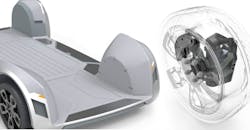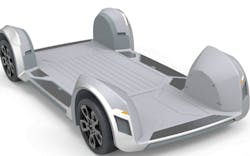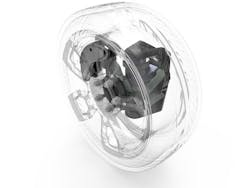Reimagining the EV: Flat Platform Aims to Slash Dev Cost, Complexity
The future looks bright for electric vehicles (EVs) despite the fact that each platform can cost manufacturers billions to design, test, and build. What’s more, carmakers often struggle to recoup these costs through pricing alone, as EVs are still built in low numbers compared to ICE vehicles. Thus, cost amortization is higher per unit.
Nevertheless, carmakers plan to grow their portfolio of electrified vehicles and they have a tailwind: Stringent fuel-economy and emissions policies are a big stimuli for OEM EV investments.
But can the development costs inherent in designing and building an EV be reduced? Israeli startup REE thinks so—the company has unveiled a flat, modular reference platform aimed at decreasing both the design effort and cost of manufacturing EVs (Fig. 1).
1. REE’s flat, modular platform trims EV footprint and weight. (Source: REE)
REE’s approach strategically places the motor, steering, suspension, drivetrain, sensing, brakes, thermal systems, and electronics into the wheels (Fig. 2), creating a truly flat platform. This design provides a low center of gravity to maximize efficiency and supports the vehicle’s agility and stability. REE’s innovation reduces the vehicle’s footprint and weight, and improves both energy efficiency and performance—aspects crucial to the electric- and autonomous-vehicle revolution.
2. The motor, steering, suspension, brakes, and electronics are all placed into the wheel. (Source: REE)
REE’s EV platform also enables better packaging of interior cabin space, motors, and battery packs without compromising safety.
The system uses four motors, steer-by-wire, a quad gear box, and an integrated suspension that automatically senses and levels the height at each wheel. Having individual motors in each wheel also creates the possibility of employing advanced torque vectoring, a method of power transfer that would improve both safety and handling.
The adaptation of REE’s universal framework will replace multiple platforms for OEMs, likely resulting in substantial savings. By enabling carmakers to utilize one platform for all of their electric vehicles, REE claims costs will be slashed while performance, safety, comfort, and energy efficiency will all improve.
The platform, REE says, offers automotive manufacturers multiple body configurations. It would provide the basis for vehicles ranging from high-performance cars to off-road SUVs with active suspension technology and even heavy-duty trucks.
The modular design, the company adds, provides a low center of gravity, thereby maximizing energy efficiency, increasing agility and stability, and improving performance. Once again, these are critical factors in the future success of the electric- and autonomous-vehicle revolution.
By integrating components formerly found under the hood of the car into the wheels, REE’s solution also reduces vehicle size and weight. “The concepts of the past are limited and restrict the ability of the automotive industry to realize the electric and autonomous reality they are striving for,” says Daniel Barel, CEO and co-founder (with Avishay Sardes) of REE. “Until now, the industry has operated by making incremental improvements on the traditional design of the automotive vehicle. At REE, we believe that in order to hasten the automotive revolution, we need to reinvent the wheel—quite literally.”
Barel and Sardes are also the founders of SoftWheel, theTel Aviv, Israel company behind an in-wheel suspension system for use in wheelchairs, bicycles, and in the automotive sector. SoftWheel's technology improves performance by using suspension arms set equidistant around a central hub to provide shock absorption, no matter the angle of impact from an obstacle. The suspension system actuates only when an obstacle or rough terrain is encountered, immediately returning the vehicle and rider to a level ride.
Going forward, REE reports it’s already collaborating with major automotive industry partners including Mitsubishi Corp., Musashi Seimitsu Industry (a Tier1 global auto parts supplier), Tenneco, American Axle, Fiat Chrysler Automobiles, and bearing manufacturer NSK.



